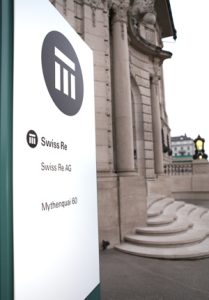Swiss Re’s Sigma report has shown global non-life insurance premiums increased by 2.8% to $2.2 trillion in 2017, slightly above the 10-year-average of 2.1% despite being a further slowdown from the past two years.
 Premium growth in emerging markets slowed to 6.1% in 2017 while growth in advanced markets remained steady at 1.9%.
Premium growth in emerging markets slowed to 6.1% in 2017 while growth in advanced markets remained steady at 1.9%.
Emerging markets continue to outpace the advanced markets by more than a factor of three. However, the absolute real premium contribution of advanced markets was slightly higher at 1.5ppts compared to emerging markets.
Advanced markets saw non-life premiums increase by 1.9% in 2017, slightly above the 10-year average of 0.9%. In the U.S., where growth was somewhat stable at 2.6%, the industry benefited from higher rates in motor business. In Western Europe, growth remained moderate but was slightly up compared to 2016 and also above the 10 year average.
While premiums continue to recover solidly in Spain and Portugal, the market in Italy is still contracting, however growth turned positive in nominal terms. Growth also improved in Oceania, supported by solid personal lines and improvement in commercial lines.
Conversely, growth slowed in all markets of advanced Asia, except Taiwan, where higher property rates and strong car sales led to some improvement, according to the report.
Non-life premiums in emerging markets grew by 6.1% in 2017, lower than the 9.8% growth in 2016 and the 10 year average of 8.4%. This slowdown was largely caused by China, where growth fell from 20% in 2016 to 10% in 2017 due to lower motor premium rates.
Nevertheless, China continues to operate as the primary engine for growth across emerging markets.
Excluding China, growth remained modest in emerging markets at 2.5% in 2017 and was robust in emerging Asia, strengthened by double digit growth in India and improvement in Thailand and Indonesia.
In Central and Eastern Europe, premiums continued to expand at a moderate 3.3% pace supported by improving economic activity, especially in some European Union member countries, which more than offset the contraction in Russia.
Meanwhile, the -0.9% decline in Latin America and the Caribbean in 2017 was less severe as Brazil and Argentina experienced positive growth.
The report indicates that premium contraction in Turkey and continuing stagnation in Saudi Arabia dragged down Middle East and Central Asia’s overall premium growth.
In Africa, premiums are estimated to have increased marginally at 1.0% due to weak growth in South Africa, while growth was mixed in other countries of the region.
Advanced markets contributed slightly more than emerging markets to real non-life premium growth in 2017. The key drivers were China and North America, which contributed 1.0ppt each. Western Europe also made a significant contribution, while advanced Asia and emerging Asia were also impressive.
The contribution of the other regions was smaller, with Latin America the only region with negative real growth.
The downward trend of the overall profitability of property & casualty insurance continued for the third consecutive year, says Swiss Re. The sector Return On Equity (RoE) declined to 5.1% in 2017 as the industry experienced underwriting losses due to heavy natural catastrophe losses in North America.
The report states that a marginal improvement in the total investment result to 9.7% of net premiums earned could not offset the underwriting losses and that the overall combined ratio (CR) for the eight major markets deteriorated from 99.4% in 2016 to 101.8% in 2017.
In the U.S., in addition to the increasing losses in motor and declining rates, the 2017 underwriting profitability was also affected by high natural catastrophe losses. Underwriting profitability remained stable in Western Europe with an average CR of around 94%‒95%. A slight worsening in Germany was offset by slight improvement in the UK, Italy and Nordic countries.
Conversely, the lack of cat losses helped to improve non-life profitability in advanced Asia, except for Hong Kong, where underwriting profits dropped significantly due to increasing provisions for A&H business. Profitability also improved in Australia, supported by higher premium rates, reserve releases and higher reinsurance recoveries for peril claims.
The overall solvency of the non-life sector reached a record high level of around 130% in 2017, up from 128% in 2016, supported by higher shareholder surplus. Capitalisation will remain strong, but support from unrealised gains will gradually weaken once interest rates begin to rise, says the report.
Looking forward, Swiss Re Institute expects that the global non-life sector will continue to improve, supported by advanced markets, which will contribute more than half of the additional premiums in absolute terms.
Premium growth in advanced markets will be driven by the U.S., where the solid economic conditions and firming prices in some lines should lead to rising premiums. Although the natural catastrophe events towards the end of 2017 triggered some rate hikes, prices increases have remained below expectations in the non-affected lines of business.
Additionally, premium growth in Western Europe is expected to remain moderate despite a comparably strong economic recovery in Continental Europe.
In advanced Asia, where a planned lowering of rates in Japan for voluntary motor will affect premium growth adversely, recent earthquakes in South Korea could increase risk awareness and demand for insurance.
Premium growth in Oceania is expected to be solid in 2018‒19, driven by continuing rate increases in motor, home and commercial lines.


